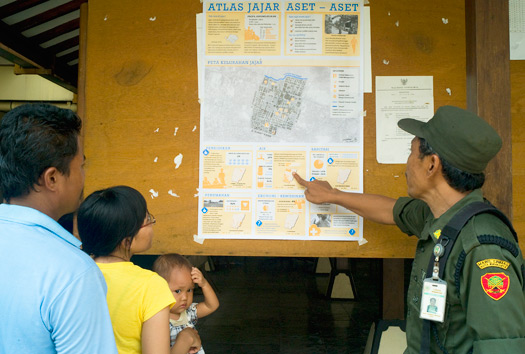 Solo, Indonesia, citizens examine a mini-atlas in a kiosk. Photo: Kheng Wee
Solo, Indonesia, citizens examine a mini-atlas in a kiosk. Photo: Kheng WeeDespite a phalanx of field workers, multilingual advertising machinery and White House agitation, the 2010 U.S. Census might be remembered as the Polaroid snapshot that never fully developed. Everything from the questionnaire’s color palette to its hot-potato ethnicity question has been invoked to explain anemic survey-return rates. The real culprit, however, was an underlying lack of civic engagement. Did non-respondents fail to grasp their role in determining governmental budgetary decisions? Regardless of their participation, did they feel such decisions were too remote to have any discernible impact on their lives?
A budgetary initiative that began last year in Indonesia does not stray from the U.S. Census Bureau’s methods or aims: gather local information, compile and condense, present to governors to determine financial allocations. Yet its unique, design-led approach has engaged citizens at all levels of society, yielding a clear-eyed assessment of actionable budgetary items for 2011 as well as a graphics-rich profile of a society.
On printed maps, the Solo Kota Kita project presents critical information about residents’ levels of wealth and access to services. Data and maps are also available online. The initiative is currently limited to Central Java’s batik capital, Surakarta — a medium-sized city (pop. 600,000) known locally as Solo. During Solo’s annual budgeting process, called musrenbang, community leaders come together to identify projects in their districts that require governmental support in the coming fiscal year, be it street paving or waste removal. The problem, as one of Solo Kota Kita’s founders, Michael Haggerty sees it, is one of disproportionate representation.
In the urban planning community, “It’s called ‘elite capture,’ where one person’s voice prevails over others,” he explains. “This encourages a sort of planning by rumor. People come together and say, ‘We need to paint the school,’ when there might be severe problems that their reporting neglects.”
Haggerty, in collaboration with fellow Graduate School of Design alumnus John Taylor and Solo–based academics and community leaders, sought to flatten the musrenbang process by introducing a graphic tool that would represent critical data for budgetary decision-making in each of Solo’s 51 official neighborhoods. Through clean, universally recognized graphics, these so-called atlases represent each neighborhood’s offerings of potable water, education, sanitation resources and health services, among other indicators. The hope is that this straightforward data packaging, available both in English and the local Javanese dialect, will improve community awareness and — come January — compel neighborhood leaders to make better-informed recommendations during musrenbang.
This emphatically local budgeting concept is endorsed by the city’s mayor and sponsored by US AID and UN Habitat.
The project’s Solo–based director, Ahmad Rifai, illustrates one way that a neighborhood atlas might affect planning decisions for the batik-intensive neighborhood of Laweyan. “The atlas describes that many Laweyan households use private wells,” he writes. “However, Laweyan is growing with the batik business, which causes water pollution. So, the atlas will be a good tool to [advocate for] providing a pipe-water connection in Laweyan.”
The atlases also encourage planners to correlate disparate data sets. For example, poor water provisioning might afflict a neighborhood that also suffers above-average poverty. Representing these facts together on the atlas’s map emphasizes their interconnectedness and prevents a hierarchy of social ills from developing.
Solo Kota Kita’s efficacy will come into sharper focus in January, after neighborhood leaders have presented their atlas-informed budget recommendations during musrenbang. Whether or not the city acts on these, participants will still possess a powerful tool for understanding community resources that could find adoption elsewhere in Indonesia. That is a return on investment to be proud of.
